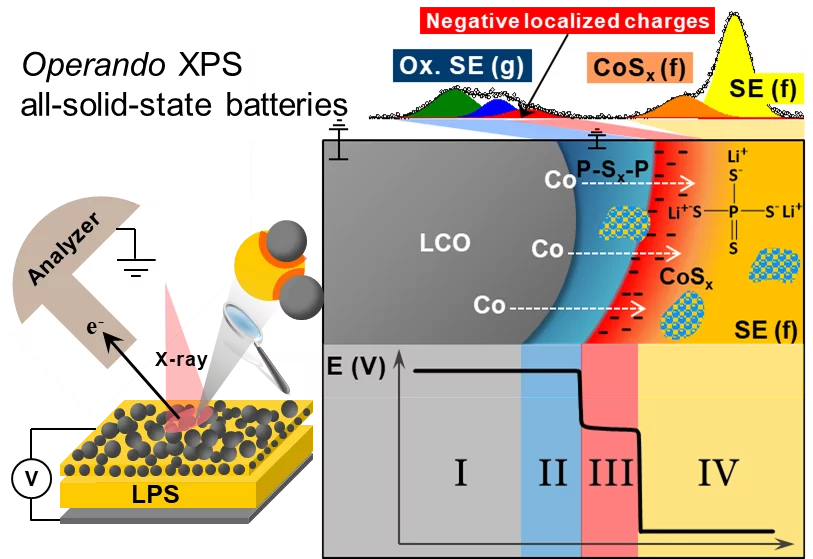All-solid-state lithium batteries are a promising alternative for next generation of safe energy storage devices, provided that parasitic side reactions and the resulting hindrances in ionic transport at the electrolyte-electrode interface can be overcome. Motivated by the need for a fundamental understanding of such interface, we present here real-time measurements of the (electro-)chemical reactivity and local surface potential at the electrified interface Li3PS4 and LiCoO2 using operando X-ray photoelectron spectroscopy.
While state-of-the-art lithium-ion batteries (LiBs) are reaching their inherent performance limits in respect to energy density and safety, all-solid-state batteries (ASSBs) are a promising alternative for boosting the volumetric energy density, with superior safety characteristics. In the past decades, significant progress has been made in the discovery of solid-state ion conductors capable of achieving room temperature ionic conductivity comparable to their liquid homologues. However, poor mechanical contact and parasitic (electro-)chemical side reactions act to limit ion transport across the solid electrolyte (SE)-active materials (AMs) interfaces. The chemical and electronic nature of the latter is distinctively different in ASSBs from the conventional LiBs. For the liquid electrolyte system, an excellent understanding of electrified liquid-solid interfaces has been achieved theoretically and experimentally through the detailed investigation of the electrochemical double layer and the solid-electrolyte-interphase. Today, this fundamental knowledge provides important guidance towards improving performance parameters, such as reducing charge-transfer resistances of energy storage and conversion devices. Similarly, interactions at the electrified SE-AMs interfaces play a critical role in the performance of ASSB devices, but the full picture of the exact mechanisms associated with the (electro-)chemical reactions and the electronic properties, monitored in real time upon cycling, has not been fully achieved yet. To bridge this gap, we investigate the (electro-)chemical and electronic processes occurring at a representative interface between a cathode AM LiCoO2 (LCO) and the glassy SE Li3PS4 (LPS). Despite the high room temperature ionic conductivity of LPS (approx. 0.4 mS cm 1), it suffers from a narrow electrochemical stability window, which is a drawback for practical applications. As shown in several post-mortem X-ray photoelectron spectroscopy (XPS) studies, delithiation of LPS occurs with polymerization of the PS43- tetrahedra via polysulfidic bridges upon cycling the cell up to high voltages. In addition to the intrinsic instability of LPS at the operation potentials of common cathode AMs, a mutual diffusion region, where both ions and electrons are mobile, has been suggested to occur. The formation of an interlayer through inter-diffusion of species across the SE-AMs interface is known to increase further the charge-transfer resistance. Concerning the electronic properties of the interface, the fundamental difference between electrified solid-solid and liquid-solid interfaces lies in the electrical potential profile. In a standard model, an electrified liquid-solid interface is characterized by the existence of an electrochemical double layer leading to the formation of a potential drop region ranging from several atomic layers to tens of nm depending on the electrolyte composition and concentration. However, although expected, little is known whether there is an analogous distribution of charges occurring across the electrified cathode AMs-SE interface. Important parameters, such as potential profile across the interface, charge distribution, and the impact of defects have been difficult to access experimentally. Nevertheless, during battery cell cycling outside the electrochemical thermodynamic stability window of the SE, the chemistry and electronic properties of the interface become very complex, in particular, since SE degradation byproducts and transition metals inter-diffusion are likely to occur. In this study, we address the evolution of the (electro-)chemical reactions and electronic properties of the interface in a compressed powder mixture of LCO and LPS by using the operando XPS electrochemical cell developed for ASSB. We carried out real-time measurements of an operating working electrode to obtain a detailed picture of the reactions occurring at the interface of an LCO-LPS. Specifically, we identify the onset of oxidation of the LPS at 2.3 V vs. InLix, which is followed by Co-ion diffusion into the LPS at 3.3 V vs. InLix to form CoSx species. After LPS oxidation, a localized negative charge layer is detected at the LPS-LCO interface causing a local surface overpotential of approximatively 0.9 V. Furthermore, we demonstrate that an abrupt potential variation is present at the interface between the AMs and SE, confirming previous theoretical predictions of a narrow space charge layer at the interfaces of ASSBs. Finally, with the support of X-ray photoemission electron microscopy (XPEEM), we reveal the existence of chemical reactivity between LCO and LPS, leading to the formation of reduced Co in a +2 oxidation state at the LCO surface occurring right after mixing the powder.
Contact
Dr. Mario El Kazzi, Group Leader of Battery Materials and Diagnostics
Paul Scherrer Institut
5232 Villigen PSI
Telephone: +41 56 310 51 49
E-mail: mario.el-kazzi@psi.ch
Original Publication
Reactivity and Potential Profile across the Electrochemical LiCoO2–Li3PS4 Interface Probed by Operando X-ray Photoelectron Spectroscopy
Xiaohan Wu, Marta Mirolo, Carlos A. F. Vaz, Petr Novák, Mario El Kazzi
ACS Appl. Mater. Interfaces 13, 42670−42681 (2021)
DOI: 10.1021/acsami.1c09605
Acknowledgements
Part of this work was performed at the Surfaces/Interfaces Microscopy (SIM) beamline of the Swiss Light Source (SLS), Paul Scherrer Institut (PSI), Villigen, Switzerland.

